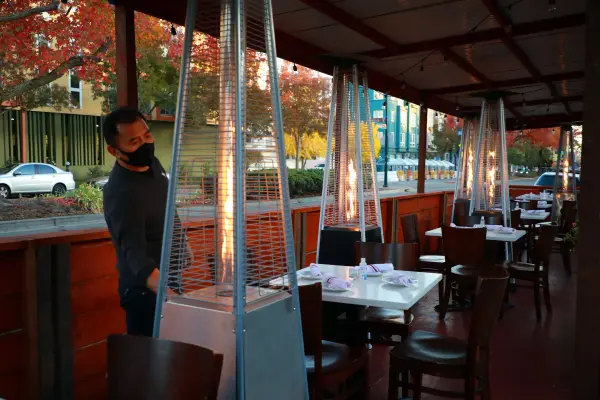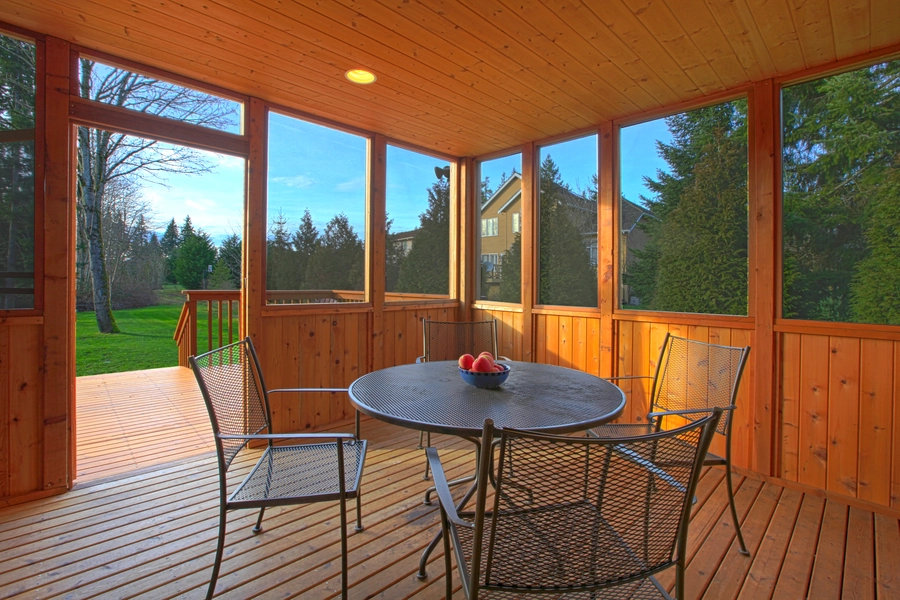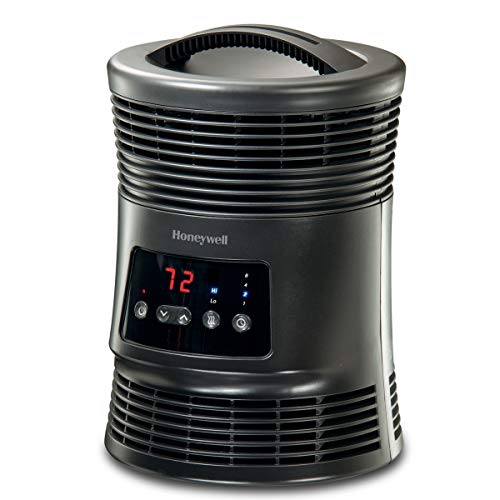You’ve spent the warmer months eating dinner, entertaining guests, and enjoying your screened porch, but now the weather is turning against you. What options do you have if the weather is beginning to cool off, but you aren’t ready to give up your back porch life? Keep reading to see what options are available for heating your porch.
Can I heat a screened porch?
You will be happy to hear that; yes, you can heat your screened porch. Of course, with a screened porch, heat is easily lost, so it is not an ideal long-term solution. And for larger porches, you will need to use more than one heater or have a more focused heating solution. But for dinner or games outside, it can make a cold day more comfortable.
What to consider when choosing a heater
When considering heaters to help you keep warm in your screened porch, many different options are available. Here are some things to consider:
Choosing a fuel type
Choosing the fuel source is the first thing you must consider when deciding what kind of heater to purchase.
- Electric: There are plenty of heaters on the market that use electricity. Being able to plug into a wall outlet is convenient and makes it easy to relocate or remove the heater when it’s not needed. However, they can be expensive to operate depending on energy costs in your area.
- Natural gas: Natural gas is the way to go for the most “finished” or built-in product, but it requires your home to have a natural gas service. You’ll also need the heater plumbed into your gas line system. The heater is relatively inexpensive to run but would come with the highest initial cost. It would be easiest to integrate into your home during construction or a renovation but could be done at any time if desired.
- Propane: Propane heaters can either be portable (utilizing smaller propane tanks) or more permanent when plumbed to a larger remote propane tank. If you’re planning a substantial heating source (like installing a gas fireplace), the larger tanks are the way to go, otherwise the portable solution is easiest.
- Wood: Installing a wood fireplace is not common but could also be a possibility. It would be costly to build because it would require a chimney to safely remove smoke, but nothing beats the feel and ambiance of a fire!
Fixed vs. portable
Fixed options are great if you plan to use the heater often. You may want a heater mounted above your patio table or furniture. Or you could mount it to the wall, so you don’t have to worry about it where it is; it’ll always there and ready to turn on.
If you only plan to heat your porch on occasion or are trying to keep costs down, you could have a more portable option. These tend to be cheaper and a heater that you can move allows you to target a certain area rather than trying to warm up the entire space.
Convection vs. radiant heaters
You may not be aware, but radiant heaters are also an option. They are less common in residential applications, but not uncommon in commercial situations. Here are the differences:
Convection heating is what we think of when we think of a typical heater. It will heat the items in front of it, but it will also heat the air in between. This makes it a less efficient heating option in a screened porch because it must also warm up the air around itself. But it is a better option if you are trying to keep an entire space warm for that exact reason.
Radiant heat will radiate heat outward using waves to heat the objects it’s facing. The waves will heat the objects, but they will not heat the air. Think of sitting in the sun on a spring day. The air might be cool, but you can feel the heat from the sun on your body. This is radiant heat.
Radiant heat is not an efficient way to heat a room. It will have some effect due to the heat reflecting off the materials that it’s warming. It’s best used when pointed towards the occupants to warm them. For example, installing a radiant heater on the ceiling directly above the table would be an effective use, provided that there is nothing between the heater and the people at the table (like a ceiling fan).
Examples of how to heat a screened porch
You might consider a wall or ceiling-mounted radiant heater. These work very well for smaller spaces in that you can focus the direction of the heat on the location where you will be spending the most time, such as above the patio table.
This infrared heater can be mounted to the wall or ceiling, vertically or horizontally, and comes with a remote for easy control. It’s budget friendly, but only puts out around 5,000 BTUs.
If you don’t want to mount your heater, this tower option is a great choice. This particular model has a remote and 3 different power settings.
A common option for heating outdoor areas that become popular during the pandemic is a style that looks like a giant lamp. These can even be purchased to look like an old-time streetlamp and are offered in electric, propane, or natural gas models. Be warned: the fuel-burning models are much more hazardous for porches since they are highly flammable and can produce carbon monoxide. They also tend to be tall, so make sure you know what clearance the manufacturer requires between the top of the heater and the ceiling. Your average home’s screened in porch likely won’t have the height or space needed.
Propane heaters like these have become popular recently but require certain clearances and use open flame, so may not be right for your home.
Image source

A better propane heater might be a smaller and more portable propane option.
The Mr. Heater F232000 is a much better option if you want to use a propane heat source. It can use either 1lb or 20lb propane tanks and can heat approximately 225 sq ft. Most importantly, it has safety features including an automatic shut off if it is tipped over, the pilot goes out, or it detects low oxygen levels.
A tabletop or floor heater is also a good option if you plan to spend most of your porch time at a table, which could involve eating dinner or entertaining guests for drinks. Once again, you will need to be cautious if you choose a fuel-burning option, especially if there are children around who might touch the heating element or knock it over.
A small space heater like this one could be set to 360 degree output and placed below the table to keep everyone warm.
If you like the idea of wood as a fuel source, there are a few options. Just like you can install a wood stove in your home, you could install a wood stove on your porch. This is more expensive than the previous options, but might be a great solution if you are considering closing in or finishing your screened porch over time.
Here’s a great example of an elegant fireplace installed in a screened in porch.
Image source

Here’s an example of a typical pedestal wood stove that is available to buy online. It’s fully enclosed making it a safer wood burning option. There are clearance requirements for any wood burning fireplace or stove, so make sure you have the room that your particular stove needs before buying.
Are propane heaters safe for a screened porch?
You’ll want to remember that gas heating appliances are not designed to be used in an entirely enclosed location. They’re only safe if you have proper airflow through the screens so that the carbon monoxide can escape from your porch. If your porch does not have an adequate air flow, then you will not be able to use gas-heated appliances unless the appliance can directly exhaust to the exterior (like the furnace in a basement). However, they can be used if specific minimum requirements are met:
- If the space is large enough to accommodate at least three feet above the heating source, and the roof or any upper structures are not in danger of catching fire. The clearance above might be reduced with reflectors, but that would be manufacturer dependent.
- Propane heaters can be used around porch furniture, including wooden furniture and umbrellas. However, the area will have to be large enough that the heater can stay at least six feet away from all furniture and anything else flammable.
- Do not use a propane heater if your screened porch does not have an appropriate amount of ventilation. Fuel-burning heaters create carbon monoxide fumes and are not designed to be in an enclosed space. Operating a fuel-burning heater in an enclosed space can cause harm.
These are general guidelines and may differ depending on the heater. Please, always refer to the manufacturer’s instructions.
Warnings?
The most significant hazards of trying to heat a screened porch are potential for burns, fire, or carbon monoxide, but they are all managable.
You’ll want to ensure that all combustible items are kept at a safe distance. This would include the railings and the roof of the porch itself. Likewise, you’ll want to make sure the heater is out of the reach of children.
Electric heaters are just as capable of starting a fire and must be placed in safe locations without flammable items too close to them. Just because it does not have an open flame does not mean it isn’t still potentially dangerous. Although, electric heaters with ceramic heating elements are becoming more commonplace now and are cool to the touch and, therefore, much safer.
Carbon monoxide from burning your fuel source will be a considerable concern. You will need to be sure that your porch has adequate air traveling through it so that the carbon monoxide will not gather and potentially harm the occupants.
Final thoughts
There are plenty of options to help keep you comfortable when you’re enjoying a cooler day on your porch, or trying to squeeze the last days out of summer. Although there are some things to be cautious about, heaters can be used in screened-in spaces. For many people, radiant heaters are the easiest, safest, and best solution for your screened in living area.









